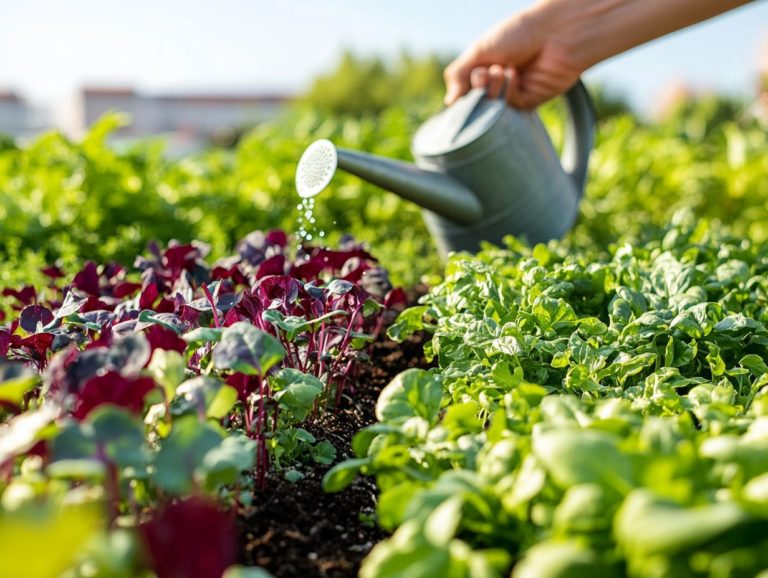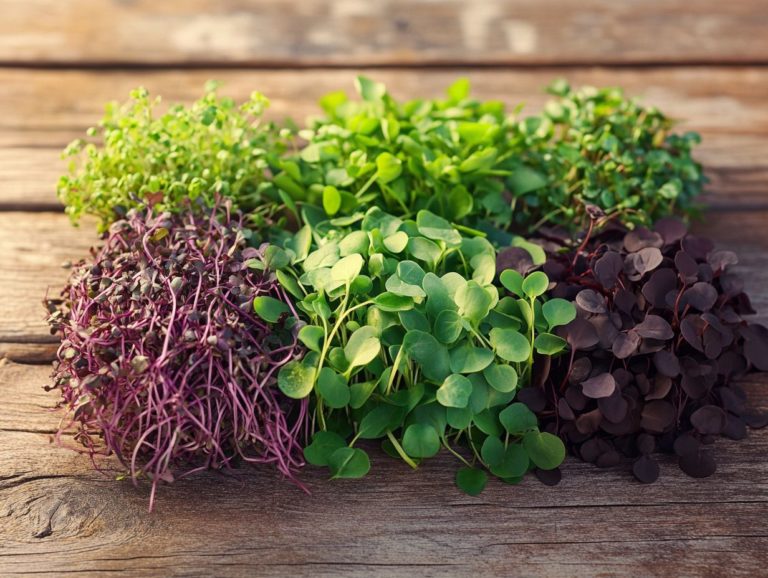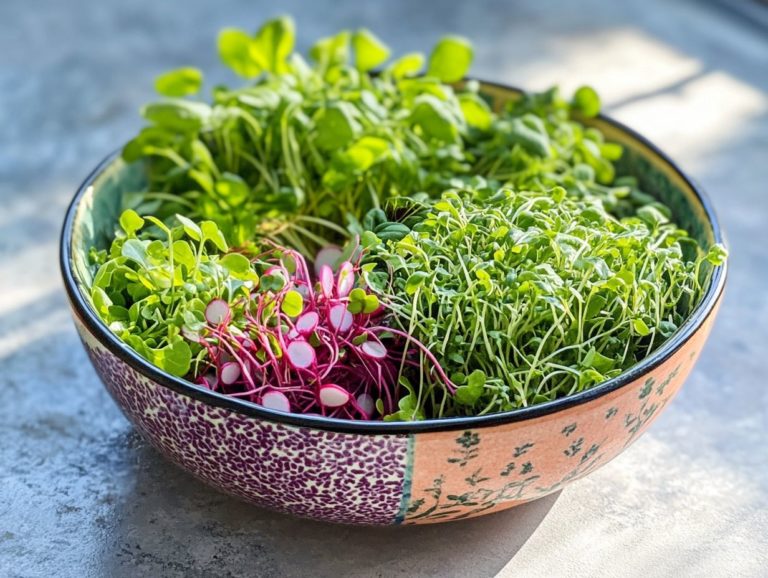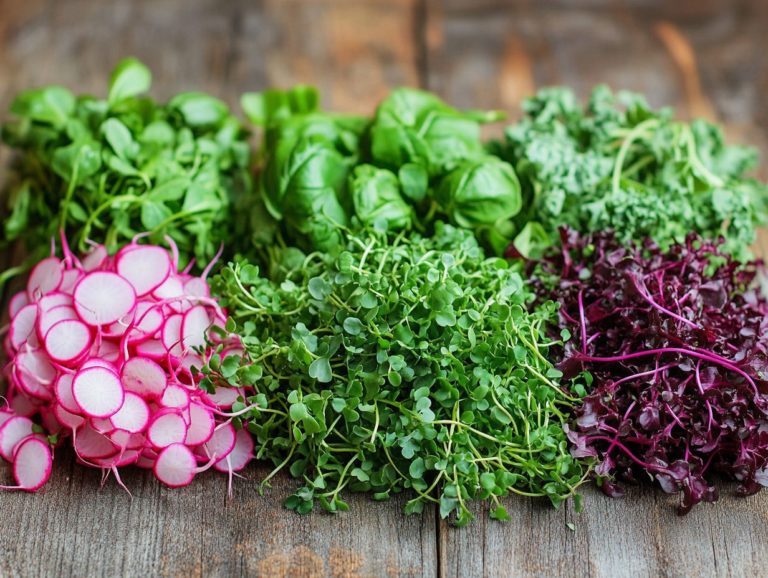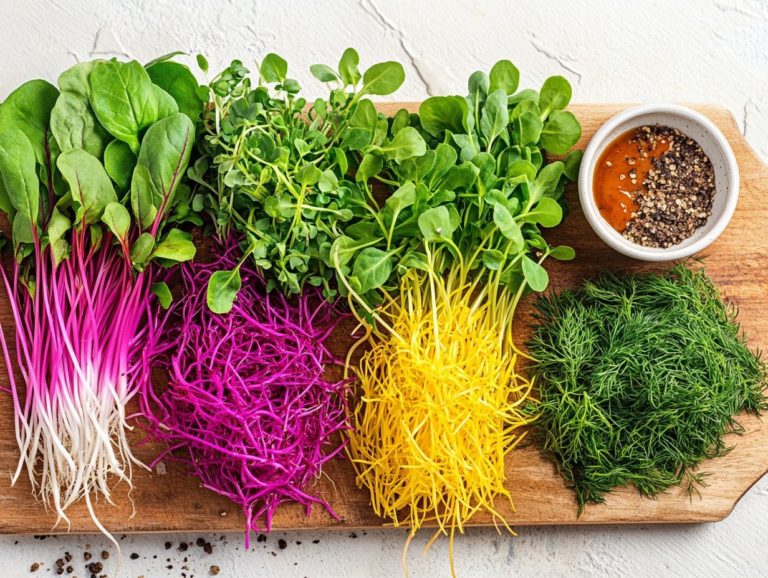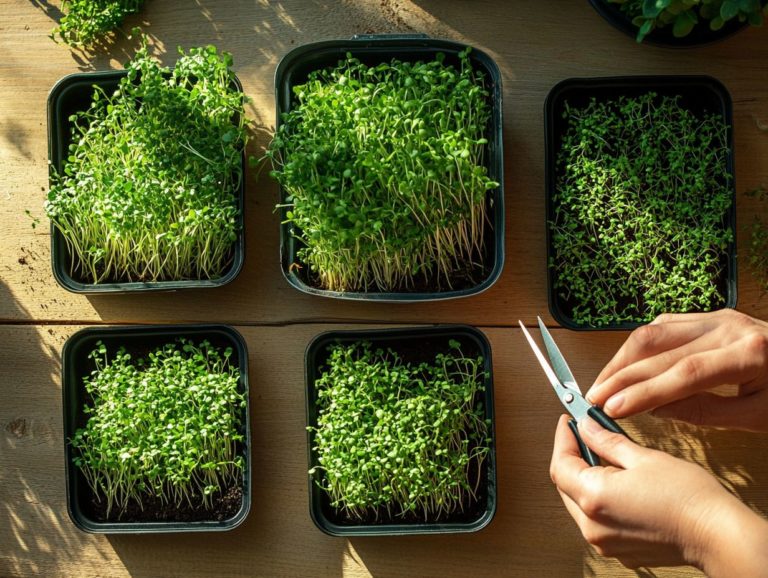Must-Try Microgreen Varieties for Salads
Microgreens are tiny, flavorful powerhouses of the plant world. They infuse your salads with vibrant color, texture, and a delightful burst of nutrition.
In this article, you ll discover a curated list of must-try microgreen varieties that make your salads special. Imagine the sweetness of pea shoots mingling with the peppery bite of radish microgreens these little greens pack a serious punch.
You will also learn how to grow them at home and uncover their impressive health benefits. Get ready to see how microgreens can completely change your meals for the better!
Contents
- Key Takeaways:
- 1. Pea Shoots
- 2. Sunflower Shoots
- 3. Broccoli Microgreens
- 4. Radish Microgreens
- 5. Cilantro Microgreens
- 6. Arugula Microgreens
- 7. Kale Microgreens
- 8. Beet Microgreens
- 9. Red Amaranth Microgreens
- 10. Basil Microgreens
- 11. Wheatgrass
- 12. Chia Microgreens
- 13. Mustard Microgreens
- 14. Fennel Microgreens
- 15. Dill Microgreens
- What Are Microgreens and Why Are They Good for Salads?
- Frequently Asked Questions
Key Takeaways:
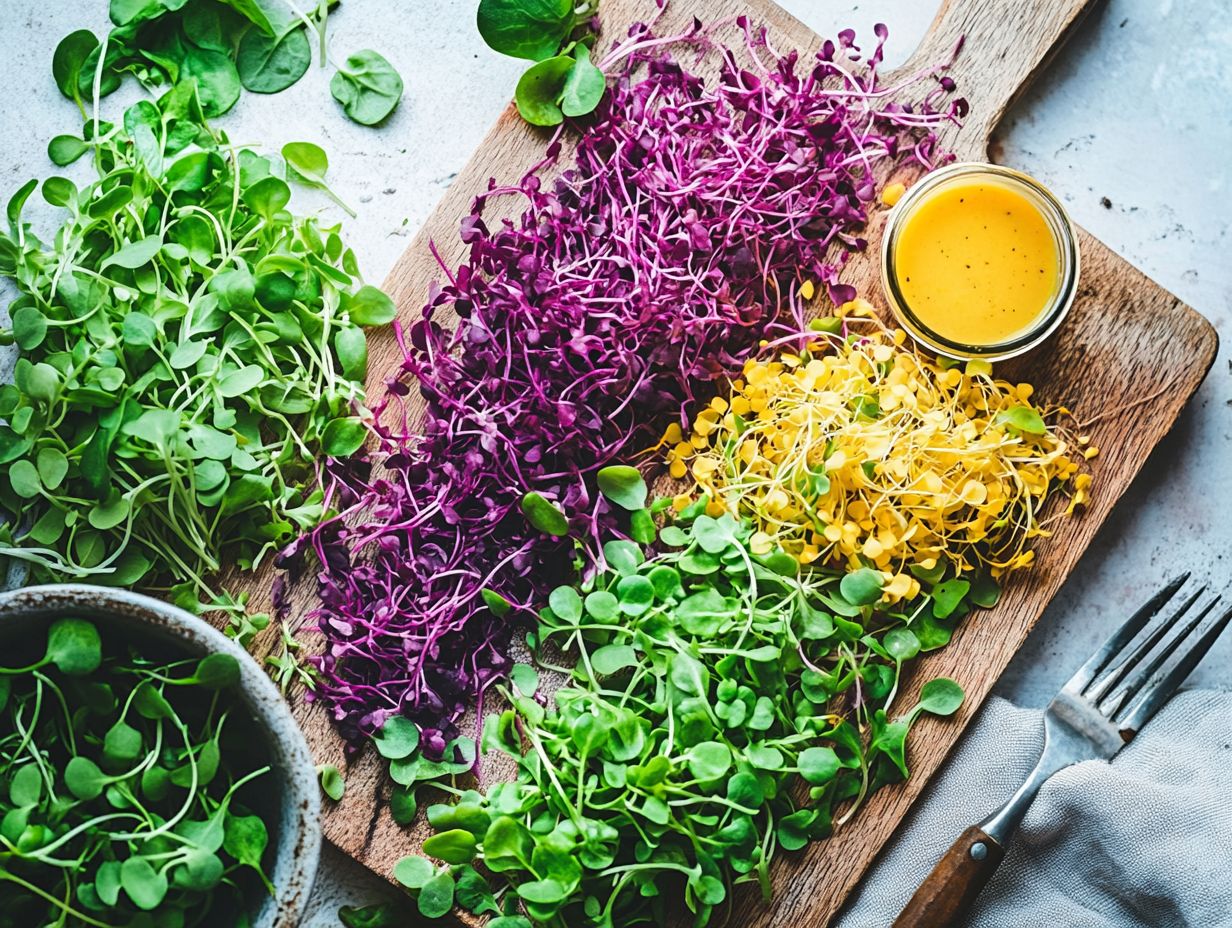
- Refresh your salads with nutrient-packed microgreen varieties like pea microgreens, sunflower microgreens, and broccoli microgreens.
- Add a punch of flavor and texture to your salads with microgreens like cilantro, arugula, and kale.
- Experiment with unique microgreen varieties like chia, fennel, and dill to elevate the taste and nutrition of your salads.
1. Pea Shoots
Pea shoots, with their vibrant green hue and delicate flavor, are a type of fast-growing microgreen. They have undoubtedly captured the attention of health-conscious eaters seeking nutritious enhancements for meals, especially in salads and appetizers.
These tender edible leaves are easy to grow indoors and serve as a versatile ingredient in fine dining establishments across California and beyond. Their importance is particularly relevant in the era of food sustainability.
Rich in vitamins A, C, and K, along with various antioxidants, these shoots bring a subtle sweetness and hint of nuttiness to the table. They are a perfect complement to a range of dishes.
Pea shoots elevate sandwiches with a fresh topping that adds texture and burst of flavor. They can also be seamlessly blended into smoothies for that extra nutrient boost, showcasing their versatility in many cooking techniques.
When crafting a salad, mix them with citrus-based dressings to enhance their flavor. For an elegant touch, consider garnishing soups and entrees with these vibrant greens, transforming ordinary meals into visually stunning creations.
2. Sunflower Shoots
Sunflower shoots have become a sought-after superfood among health-conscious individuals like you. They are celebrated for their delightful crunch and nutty flavor, effectively elevating salads, sandwiches, and various dishes.
These tender greens come packed with an impressive array of nutrients, rich in vitamins A, B, C, and E, as well as essential minerals such as calcium, iron, and magnesium. Their unique taste enhances the flavor of your dishes and elevates the nutritional value.
Incorporating sunflower shoots into your smoothies provides a refreshing energy boost. You can also use them as an elegant garnish on gourmet plates, showcasing their remarkable versatility.
Fresh sunflower shoots are a staple at farmers markets, enchanting both chefs and home cooks eager to add a touch of the extraordinary to everyday meals.
3. Broccoli Microgreens
Broccoli microgreens are a treasure trove of antioxidants and essential nutrients, making them a top choice for those prioritizing superfoods in their diet, especially in salads and fresh dishes.
These vibrant seedlings not only elevate the flavor of meals but also play a significant role in disease prevention. Packed with vitamins C, E, and K, they provide a robust boost to your immune system and help combat inflammation.
Incorporating them into daily recipes is easy. You can sprinkle them on sandwiches, blend them into smoothies, or toss them into stir-fries for an irresistible crunch. They are particularly popular in seasonal eating practices.
If you’re considering home gardening, using a quality soil mix enriched with organic compost will promote optimal growth. These microgreens flourish best in a nutrient-rich environment, ensuring a steady supply of their remarkable health benefits at your fingertips.
4. Radish Microgreens
Radish microgreens add a delightful spicy kick to your dishes. They attract health-conscious consumers and culinary enthusiasts alike.
They ve become a go-to choice for salads and a stunning garnish in fine dining presentations. These vibrant greens offer a distinct peppery flavor that enhances your meals and delivers a remarkable nutritional boost.
Packed with vitamins A, C, E, and K, along with essential minerals like calcium and magnesium, they support your overall health and wellness.
Imagine tossing them into a refreshing summer salad, layering them on a gourmet sandwich, or blending them into a zesty pesto. The versatility of radish microgreens is unmatched, making them an ideal ingredient in seasonal salad preparations.
Their seasonal availability makes them an excellent choice for farm-to-table meals. You can enjoy fresh, wholesome ingredients that are as visually captivating as they are delicious.
5. Cilantro Microgreens
Cilantro microgreens bring a fresh, vibrant flavor that elevates a variety of dishes. They re essential for those who appreciate bold cooking ideas in their salads and appetizers, particularly in Mexican cuisine.
These petite greens add a delightful pop of color to your plates. They also infuse a unique zest that harmonizes beautifully with cuisines from around the globe especially in Mexican, Indian, and Thai dishes.
Packed with vitamins A, C, and K, along with essential minerals, they deliver a powerful boost that supports a healthy lifestyle.
If you have a green thumb or even if you think you don t growing cilantro microgreens at home is simple. They require minimal space and just a few basic supplies.
With a bit of care, you can cultivate these flavorful gems, ensuring that fresh greens are always within reach.
6. Arugula Microgreens
Arugula microgreens are a true culinary gem, celebrated for their peppery flavor and impressive nutrient density. They’re perfect for health-conscious individuals looking to elevate their salads and gourmet dishes with fresh, edible greens.
These petite powerhouses deliver a bold punch of flavor while being rich in vitamins K and C. They provide a vibrant boost to your overall health.
You can toss arugula microgreens into a simple salad featuring ripe tomatoes and creamy avocado. They re also fantastic in smoothies, sprinkled atop pizzas, or incorporated into wraps. This effortlessly enhances flavor profiles while delivering essential nutrients.
By embracing these microgreens, you can easily integrate a more nutritious diet into your lifestyle without compromising on taste. Enjoy flavors that significantly enhance your meals.
7. Kale Microgreens
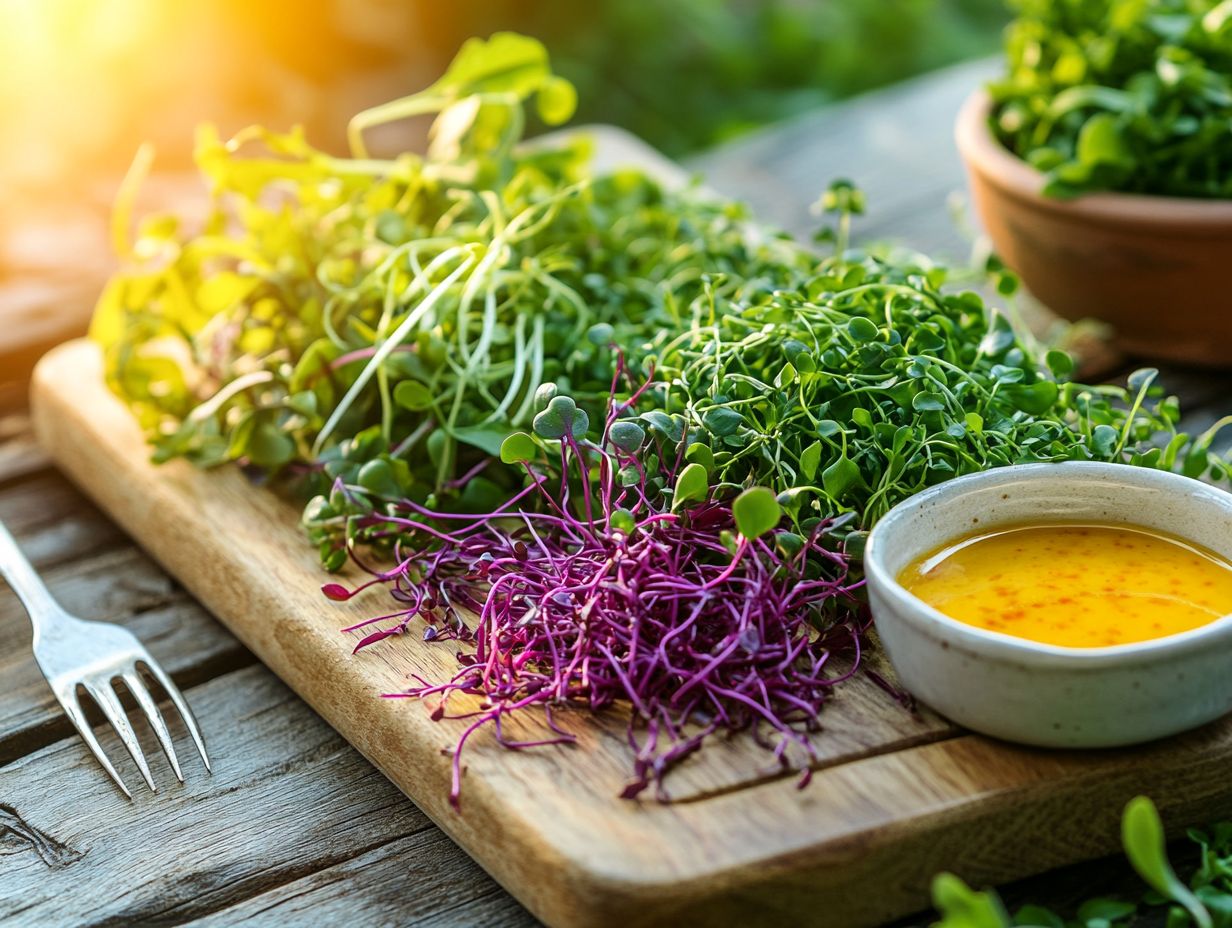
Everyone loves kale microgreens for their superfood qualities! If you’re health-conscious and eager to elevate your meals, incorporating these nutrient-dense greens into your salads and dishes is a delightful choice.
Loaded with vitamins A, C, and K, kale microgreens are low in calories yet bursting with antioxidants. They actively combat oxidative stress in your body.
Their vibrant, tender leaves bring a robust flavor, making them an exquisite addition to a range of culinary creations. You might find chefs sprinkling them over soups, entrees, or grain bowls to add a fresh burst of color and nutrition.
Don t miss out on the chance to boost your meals with these amazing greens! Consider blending them into smoothies or using them as a garnish to enhance both the visual appeal and health benefits of any meal.
This versatility positions kale microgreens as an exceptional choice for amplifying taste and nutritional value in your diet.
8. Beet Microgreens
Beet microgreens effortlessly bring an earthy sweetness to your salads and dishes. They cater perfectly to health-conscious individuals who value vibrant colors and delightful flavors. With a wealth of health benefits, they make a delightful component of any seasonal salad.
These petite greens are visually captivating with their striking red and green hues. They deliver a remarkable nutritional boost, loaded with vitamins A, C, and K and essential minerals like iron and calcium. Their unique flavor enhances many recipes. They elevate everything from gourmet sandwiches to simple grain bowls.
Imagine sprinkling beet microgreens on creamy avocado toast; it not only enhances the dish s visual allure but also adds a delightful crunch and a hint of peppery zest. You can also blend them into smoothies for extra nutrients or use them as a sophisticated garnish on entrees, enhancing both flavor and presentation.
9. Red Amaranth Microgreens
Red amaranth microgreens stand out with their vibrant hues and impressive nutritional profile. They are a favored choice for health-conscious individuals looking to elevate the visual appeal and health benefits of their salads and dishes, especially in fine dining settings.
These striking greens not only add a pop of color; they are also packed with essential nutrients. They boast high levels of vitamins A, C, and K, along with vital minerals. Their slightly nutty flavor and tender texture make them incredibly versatile perfect for garnishing soups, enhancing grain bowls, or taking wraps to the next level.
When compared to other microgreens like radish or pea shoots, red amaranth microgreens offer a unique taste experience while delivering a higher concentration of antioxidants and proteins. Chefs and home cooks alike recognize the magic these microgreens bring, transforming an ordinary meal into a visually stunning and nutritionally rich meal.
10. Basil Microgreens
Basil microgreens bring a vibrant burst of fresh flavor to your culinary repertoire, making them a must-have for anyone aiming to elevate salads, appetizers, and other dishes with a health-conscious twist.
These petite greens offer a sweet, slightly peppery taste that enhances a diverse array of meals from pasta and pizza to soups and sandwiches. Their vivid green hue and delicate texture not only elevate the visual appeal of your dish, but they also pack a punch in terms of health benefits. Rich in antioxidants and loaded with vitamins A, C, and K, they also contain essential oils that may help combat inflammation.
With just a sprinkle of basil microgreens on top of your creations or by blending them into pesto, smoothies, or omelets, you can effortlessly enjoy their delightful flavor while enriching the nutritional value of your meals.
11. Wheatgrass
People rave about wheatgrass microgreens for their superfood status! Thanks to their impressive nutrient profile, they are the perfect choice for health-conscious individuals who want to enhance their wellness through dietary changes, aligning with current food trends.
These delicate, nutrient-packed greens are brimming with essential vitamins, minerals, and antioxidants, particularly rich in vitamins A, C, and E, as well as iron and calcium. Their high green pigment content is thought to support detoxification, while a wealth of enzymes aids in digestion and boosts metabolic function.
To seamlessly incorporate wheatgrass microgreens into your daily nutrition, consider adding them to a nutritional smoothie or fresh juice. Here are some ideas:
- Add them to smoothies for a vibrant green boost.
- Blend them into fresh juices for an invigorating drink that highlights their health benefits.
- Sprinkle them atop salads and grain bowls for an extra burst of flavor and nutrients, particularly when combined with unique microgreens like arugula microgreens.
Their subtle earthy taste complements a variety of recipes, effortlessly promoting your overall vitality. Don’t miss out on the chance to elevate your meals today!
12. Chia Microgreens
Chia microgreens are a superfood, brimming with essential nutrients and health benefits. They cater to your desire for a diverse, health-conscious diet filled with vibrant, edible leaves, perfect for farmers markets.
These tiny powerhouses are loaded with omega-3 fatty acids, fiber, and antioxidants. They support heart health, boost digestion, and enhance immunity all in a single bite. With their slightly nutty flavor and satisfying crunch, chia microgreens can elevate your everyday dishes.
Imagine sprinkling them on salads. Not only do they offer a nutritious boost, but they also add a delightful textural contrast to your seasonal salad.
Blend them into smoothies for an extra nutrient kick or use them as a garnish for soups and sandwiches. Their versatility in modern cooking techniques makes them a must-have in your culinary repertoire.
13. Mustard Microgreens
Mustard microgreens, with their peppery flavor and vibrant hues, are essential for elevating salads and culinary creations with a refreshing twist. They are perfect for fine dining experiences.
These tiny greens are not just a feast for the eyes; they provide a great source of nutrients, offering vitamins A, C, and K, along with antioxidants that can bolster your immune function. Their distinct mustard-like bite can enhance a simple sandwich or wrap, providing a delightful contrast to creamy or savory components.
You’ll find that these microgreens seamlessly blend into soups and stir-fries, enhancing flavor without overshadowing other ingredients. For those interested in their health benefits, a nutrient comparison of popular microgreen varieties can provide valuable insights. Their versatility inspires both novice cooks and seasoned chefs alike to unleash their creativity.
14. Fennel Microgreens
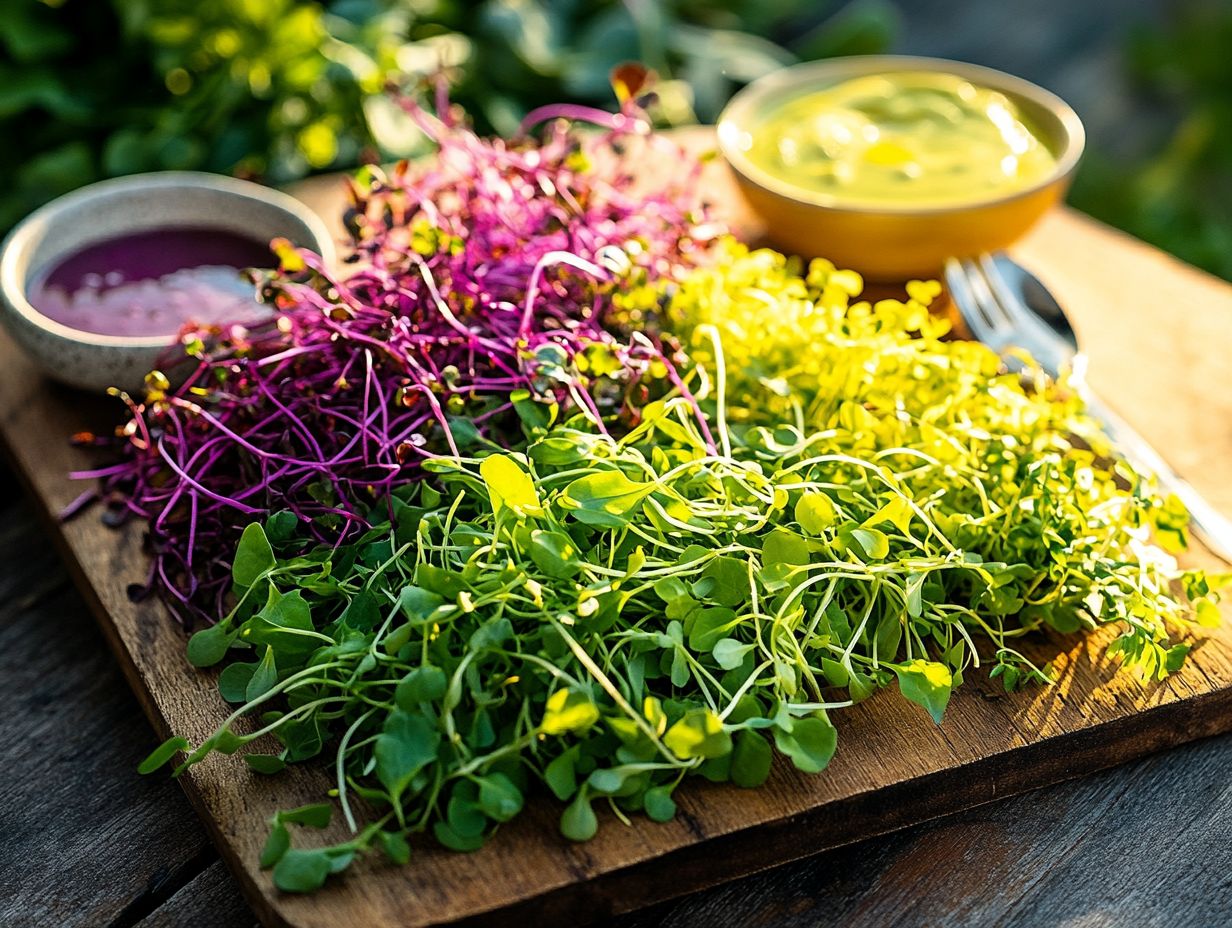
Fennel microgreens bring an anise-like sweetness that elevates salads and dishes. They are irresistible to health-conscious consumers who crave unique flavors and health benefits.
Incorporating these delicate greens into your cooking is both simple and rewarding. They enhance the taste of meals while providing vitamins A, C, and K, along with antioxidants and fiber. Consider these cooking techniques:
- Add them to sandwiches for a refreshing crunch, perhaps with some extra virgin olive oil.
- Sprinkle them over soups to deepen the flavor and add vibrancy.
- Mix them into grain bowls to amplify both taste and nutrients, showcasing the benefits of growing medium for microgreens.
With their versatility, fennel microgreens become an exciting ingredient for anyone eager to enhance their culinary experience while promoting overall wellness. For those interested in maximizing their efforts, exploring the most profitable microgreen varieties to grow can be highly beneficial.
15. Dill Microgreens
Dill microgreens bring a fresh, aromatic flavor that beautifully complements many dishes. They are a go-to choice for health-conscious consumers and chefs alike. They enhance salads and appetizers, such as Caprese salad, effortlessly.
These delicate greens add a burst of flavor that delights without overwhelming the palate. They are visually stunning and offer a nutritional boost, being rich in vitamins A, C, and K, along with essential minerals. For those interested in cultivating them, exploring seasonal microgreen varieties for year-round growth can enhance your gardening experience.
Imagine sprinkling dill microgreens on smoked salmon or folding them into creamy dips to elevate your culinary creations. For a refreshing twist, incorporate them into a yogurt-based salad dressing or blend them into a vibrant green pesto that highlights seasonal ingredients.
Their mild, slightly tangy zest enhances the flavors of omelets and grain bowls. They are incredibly versatile for your kitchen adventures, especially when paired with fresh, local greens from farmers markets.
What Are Microgreens and Why Are They Good for Salads?
Microgreens are the young, edible leaves of vegetables and herbs that you can harvest just after germination. These tiny powerhouses deliver a concentrated burst of nutrients, making them an exceptional addition to salads and a myriad of culinary creations. They are perfect for those who are health-conscious and eager to elevate both flavor and nutritional benefits in their meals.
From the vibrant zest of arugula and the delicate notes of basil to the striking colors of beet greens and radish microgreens, these tiny greens add different flavors, textures, and visual charm to your dishes. They are an excellent choice for food sustainability and are also among the best microgreens for nutritional value.
Microgreens come packed with a host of health benefits. They can help boost your immunity, improve digestion, and provide vitamins A, C, and K along with antioxidants. If you’re interested in incorporating these into your diet, you might want to explore which microgreen varieties are best for juice. These greens are a trendy and delicious choice for both chefs and home cooks, as they represent an eco-friendly cultivation option that requires minimal space and resources, promoting a healthier lifestyle in line with current food sustainability trends.
How to Grow Microgreens at Home?
Growing microgreens at home is an accessible and rewarding pursuit. You can cultivate a variety of nutrient-rich greens in even the smallest of spaces. With simple techniques and the right growing mediums tailored for indoor gardening, you can embark on this rewarding journey.
This straightforward process enhances your meals with fresh flavors while allowing you to engage in sustainable practices right from your kitchen. Selecting the right seeds is essential; popular varieties like broccoli microgreens, radish microgreens, and mustard will yield delightful results. To maximize your harvest, consider the benefits of growing diverse microgreen varieties.
Consider using a soil-less mix (a growing medium without soil that helps plants thrive) or organic potting soil to ensure optimal drainage and aeration for your greens. Using these growing mediums is crucial for successful microgreen cultivation. Once you ve planted them, these little wonders will need adequate light, moisture, and your watchful eye to prevent any pesky issues like mold.
By nurturing your plants attentively, you’ll savor the benefits of fresh produce while also deriving immense joy from watching your garden flourish. It s a rewarding experience in home gardening.
How to Incorporate Microgreens into Salads?
Incorporating microgreens into your salads can truly elevate both the flavor and nutritional value. It transforms simple dishes into gourmet experiences that cater to your health-conscious desires for fresh, vibrant ingredients, making them great for seasonal salads.
By introducing an array of microgreens like arugula microgreens, sunflower microgreens, and radish, you can create a delightful mix of textures and tastes. Imagine combining spicy radish microgreens with sweet cherry tomatoes and creamy feta cheese; the delightful contrast will tantalize your palate. Alternatively, mixing pea microgreens with tender spinach provides a refreshing and sweet base that’s hard to resist. For even more ideas, check out these ways to enhance flavor in microgreens.
When you pair these greens with citrus segments and a light vinaigrette, you amplify their natural flavors. This makes your salads not only visually appealing but also packed with vitamins. For a heartier option, consider adding quinoa or grilled chicken. To elevate your dishes further, explore a quick guide to common microgreen varieties that allows the microgreens to shine as flavorful garnishes, enhancing each bite and transforming your meal into a culinary celebration perfect for health-conscious consumers and fine dining occasions.
Start growing your own microgreens today!
What Are the Nutritional Benefits of Microgreens?
Microgreens present a remarkable array of nutritional benefits. They often contain higher concentrations of vitamins, minerals, and antioxidants compared to fully grown counterparts. This makes them an invaluable addition to your health-conscious diet, especially for those looking to incorporate nutrient-rich foods.
These tiny powerhouses are packed with essential nutrients like vitamin C, vitamin K, and iron. These nutrients contribute to your immune function, bone health, and oxygen transport in your blood. Make your meals come alive with these nutritious wonders by adding them to your microgreen salad or appetizers.
For example, studies reveal that red cabbage microgreens boast five to ten times more vitamin C than mature cabbages. This highlights their impressive antioxidant properties, which are vital for health benefits. Antioxidants help protect your cells and play a vital role in neutralizing harmful free radicals in your body. They help reduce the risk of chronic diseases such as heart disease and cancer, making microgreens a true superfood.
Incorporating a variety of microgreens into your daily meals can significantly enhance your nutritional intake and support your overall wellness.
How Do Microgreens Compare to Full-Grown Vegetables in Terms of Nutritional Value?
When you compare microgreens to full-grown vegetables, research shows that microgreens typically offer a higher nutrient content per serving. This makes them an efficient choice for health-conscious individuals like yourself who want to maximize their intake of essential vitamins and minerals.
These tiny greens are not just a garnish; they are packed with antioxidants, enzymes, and other beneficial compounds that truly support your overall health. They are perfect for growing produce at home.
For example, broccoli microgreens have been linked to cancer-fighting properties, while varieties like arugula microgreens and radish microgreens offer unique flavors and health benefits.
As you strive to make informed dietary choices, incorporating microgreens into your meals could be a simple yet powerful strategy. Whether in a Caprese salad or a refreshing seasonal salad, their concentrated nutrient profiles complement traditional vegetables. For instance, consider the top 5 microgreens for smoothies; they offer a diverse array of flavors and textures while promoting vitality and wellness, especially when prepared with extra virgin olive oil and balsamic vinegar.
Frequently Asked Questions
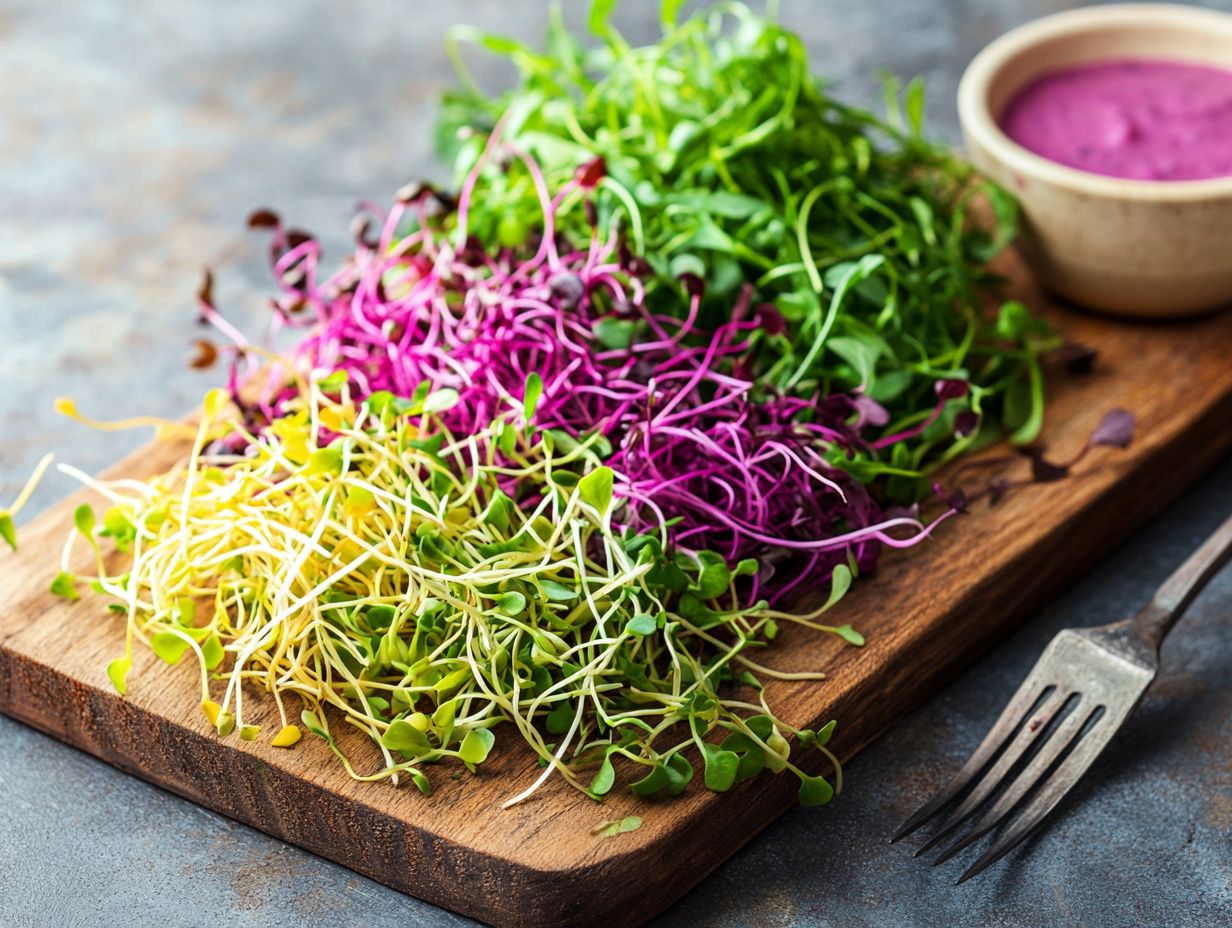
What are microgreens?
Microgreens are young vegetable greens harvested after the first true leaves have sprouted. They are smaller than baby greens but larger than sprouts, and are packed with flavor and nutrients.
Why should I include microgreens in my salads?
Microgreens add a burst of flavor and texture to salads. They are incredibly nutrient-dense, containing higher levels of vitamins and minerals compared to their mature counterparts.
What are some must-try microgreen varieties for salads?
- Broccoli
- Kale
- Arugula
- Radish
- Pea shoots
These varieties add a range of flavors, from spicy and peppery to sweet and earthy, to your salads.
How do I grow microgreens at home?
Microgreens are easy to grow at home, making them ideal for home gardening. Simply fill a shallow tray or container with growing medium, sprinkle seeds evenly, and cover with a thin layer of soil. Keep the soil moist and place it in a sunny spot. In about 1-2 weeks, your fast-growing microgreens will be ready to harvest, providing a fresh supply for your meals.
Are there any tips for using microgreens in salads?
Microgreens are delicate, so add them to salads just before serving to prevent wilting. This ensures every bite is fresh and flavorful. Mix and match different microgreen varieties, such as collard microgreens or sunflower microgreens, for a more diverse and flavorful salad.
Ready to enhance your meals? Try growing your own microgreens or include them in your next dish!
Can I use other types of microgreens in salads besides the ones mentioned?
Yes, there are endless varieties of microgreens you can use in salads. These include cilantro, basil, chia, and wheatgrass microgreens.
Try different types to discover your favorite flavors!

